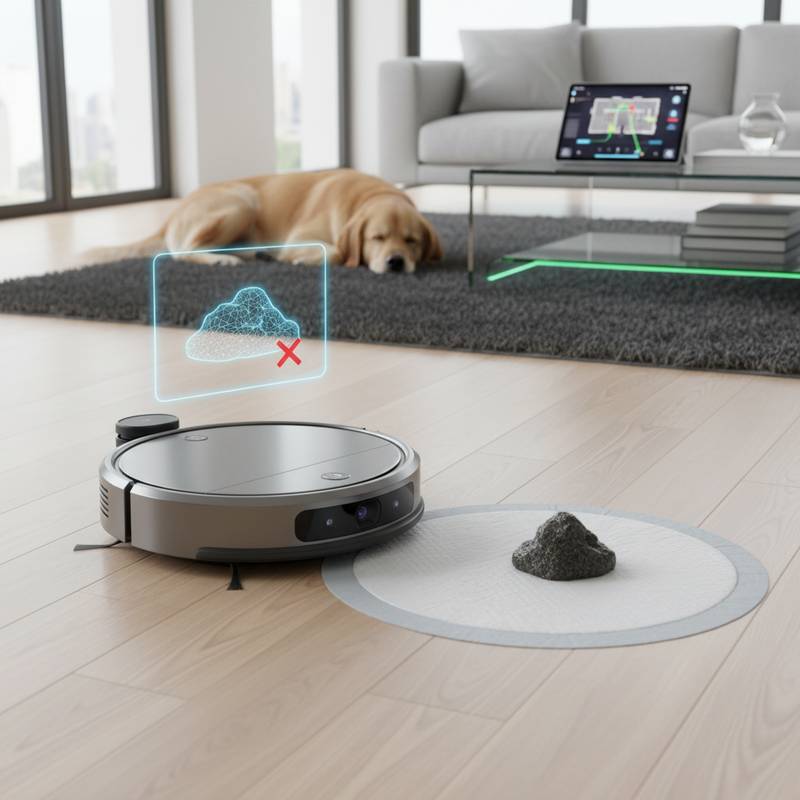Robot Vacuums Use AI to Avoid Pet Waste Messes
Smart cleaning technology has advanced significantly since the initial models that navigated rooms through trial and error. Current robot vacuums operate with greater intelligence and sensitivity to household dynamics. In homes with pets, these devices now identify and steer clear of waste accidents, preventing damage to floors and maintaining hygiene.
The Pet Problem That Sparked a Tech Revolution
Pet owners adopt robot vacuums for their efficiency in maintaining clean floors with minimal effort. However, the risk of encountering pet waste during operation has long posed a challenge. Traditional models lacked the ability to differentiate between dust and hazardous messes, often leading to contamination.
Manufacturers addressed this issue by enhancing sensor capabilities and incorporating artificial intelligence. These improvements enable vacuums to assess environments more accurately. The outcome is a device that cleans effectively while exercising caution around potential hazards.
Smarter Eyes and Sharper Minds
Contemporary robot vacuums feature high-resolution cameras, LiDAR for mapping, and structured light sensors for depth perception. Artificial intelligence processes data from these components to detect objects such as furniture, cables, and pet waste. Upon identifying a potential issue, the vacuum marks the area, reroutes its path, and notifies users via a mobile application.
This integration of hardware and software parallels developments in autonomous vehicles. The system interprets visual input rather than merely capturing it, adapting based on accumulated data. Certain models permit users to submit photos through the app, which refines the AI's detection precision over time.
Why It Matters for Everyday Living
For pet owners, this functionality builds essential trust in automation. Users expect devices to handle tasks without creating additional problems, and surveys indicate that safety ranks highly among purchase considerations. Vacuums equipped with waste avoidance directly fulfill these expectations.
The technology extends practical benefits by allowing scheduled cleanings without constant oversight. Devices can navigate obstacles, adjust routes, and provide updates, resulting in thorough cleaning and reduced manual intervention. Homeowners gain reliability in their daily routines.
Real-World Examples of AI Pet Detection
Leading brands highlight pet waste avoidance in flagship products. iRobot's system, for example, recognizes solid waste alongside items like clothing or wires, drawing from extensive image datasets for accuracy. Ecovacs and Roborock incorporate comparable object recognition in recent releases, facilitating seamless navigation.
These vacuums also identify pet-related items such as food bowls and toys to avoid disruptions. One advanced unit employs infrared detection to sense nearby animals, reducing speed or halting operation accordingly. Such features enhance the device's integration into family life.
How AI Recognition Works Behind the Scenes
Machine learning and computer vision power the detection process. Developers train models using vast collections of annotated images depicting various waste forms, illumination levels, and surface types. The AI identifies distinguishing characteristics like form, hue, and contour.
In operation, the vacuum matches sensor data against its trained knowledge base. Matching patterns trigger avoidance protocols, designating areas as restricted. Some units process information on-device for privacy, while others leverage cloud resources for ongoing enhancements. User input via apps further optimizes performance.
The Challenge of False Positives and Privacy
Detection systems occasionally misinterpret elements like hair clusters or patterned rugs as waste. Engineers mitigate these errors through iterative training and software patches. A conservative approach, where the vacuum skips uncertain areas, proves preferable to potential mishaps.
Camera usage raises privacy questions regarding home mapping and imagery. Brands counter this with data encryption, on-device computation, and user-configurable options for information sharing. Clear policies on data handling foster greater consumer confidence and adoption.
Making Pet Detection Part of a Smarter Home
Future developments focus on ecosystem connectivity. A vacuum detecting waste can interface with home cameras to alert users remotely and integrate with voice assistants for notifications. Certain setups link to air quality systems, activating purification in impacted zones.
This interconnected approach supports broader smart home strategies. Devices collaborate to streamline tasks and respond dynamically to conditions. Pet owners benefit from proactive management that minimizes disruptions and supports effortless maintenance.
The Broader Influence of AI Cleaning
Pet waste detection represents one application of versatile AI capabilities. The underlying technology also spots liquid spills, accumulated debris, or high-traffic dirt zones. Upcoming iterations may analyze usage patterns to optimize cleaning frequency or recommend layout adjustments.
Industry forecasts indicate sustained growth in smart cleaning adoption, driven by features tailored to pet households. What began as luxury items now serve as indispensable aids for hygiene and efficiency. These advancements transform routine upkeep into a seamless process.
Choosing the Right Pet-Safe Robot Vacuum
Select a model suited to pet environments by evaluating these essentials:
- Obstacle detection powered by cameras or light-based sensors for precise navigation.
- Waste avoidance that automatically identifies and bypasses accidents.
- Room mapping with options to set virtual barriers for controlled cleaning.
- Mobile app support offering live notifications and image previews.
- Data security features allowing oversight of visual information collection.
Higher-end options with these attributes involve greater initial expense but deliver long-term value through reduced maintenance needs. They safeguard surfaces and simplify pet-inclusive living.
Advancing Home Hygiene with Intelligent Partners
AI-enabled waste detection elevates robot vacuums to intuitive allies in household care. These devices adapt to specific needs, from pet behaviors to daily schedules, ensuring consistent cleanliness. As capabilities expand, they promise environments that anticipate and address family requirements.
Pet owners experience reduced stress and enhanced enjoyment of companionship. The progression toward responsive automation underscores technology's role in practical, empathetic support. Clean homes become a natural extension of thoughtful design.
